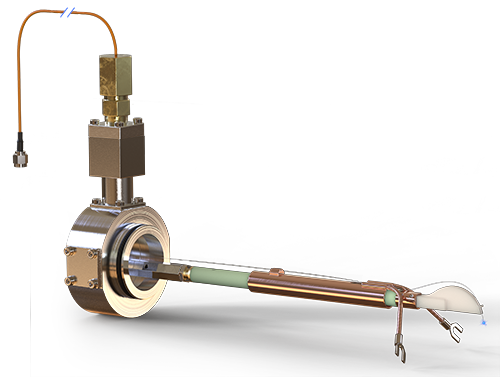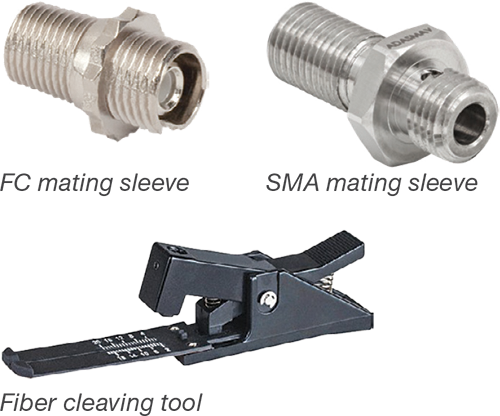Fiber optic probes and cables

Designed for simultaneous illumination of or collection from an electrically-probed wafer-level device, the fiber optic probe arm features a continuous, vacuum-sealed length of fiber from connector to probe end for maximal optical throughput. Outside the vacuum chamber, there is 2.0 m of jacketed fiber terminated with either an SMA 905 or FC connector. Inside the probe station, a 0.4 m long coated fiber (with no jacket) terminates with a flat cleaved end. The cleaved end of the fiber is threaded into a fiber holder specially designed to reduce fiber breakage with inadvertent fiber/substrate touches. If the cleaved end is damaged or dirty, the fiber end can be stripped and re-cleaved.
| Feedthrough | Wavelength (nm) | Core/cladding diameter (µm) | Connector type | Connector polish | Numerical aperture |
| Single-mode (SM) | 1290 to 1650 | 9/125 | FC | Flat | 0.14 |
| Step index multimode IRVIS | 400 to 2100 | 200/240 | SMA | Flat | 0.22 |
| Step index multimode UVVIS | 200 to 900 | 100/140 | SMA | Flat | 0.22 |
Single-mode—for illumination of a device from a coherent source such as a fiber-pigtailed laser diode. This fiber is typically customized for different wavelengths or with an APC connector polish (to match the source). Single-mode, polarization-maintaining fibers are available for applications with a coherent, polarized source (a ferrule probe holder is used to adjust incident polarization).
Multimode IRVIS—can be used with coherent and incoherent (such as an LED) sources for illumination of a device at visible and IR wavelengths as well as collection of light from a device. This fiber is commonly customized with smaller core sizes, a 0.37 numerical aperture, or with an FC connector. Mid-IR is available upon request.
Multimode UVVIS—often used to collect light from wide-bandgap devices or illuminating devices with a UV light source. This fiber can be customized with smaller core sizes, a 0.12 numerical aperture, or with an FC connector.
Accessories (coming soon)







